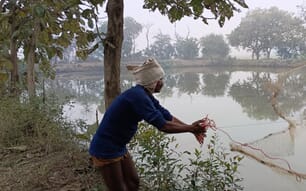These fishes belong to riverine environment. When cultured in standing water bodies such as ponds and tanks, they attain maturity, but normally do not breed under confined conditions, reports
TheHindu.
Special attempts are therefore made to breed them by artificially creating riverine conditions and stimulating their endocrine system. The technique of breeding fish by other than its natural course is known as induced breeding. Scientists have developed induced breeding techniques for production of quality fish seed of cultured varieties. It is one of the dependable methods of producing pure seed of desired species of fish.
Further, this technique is recommended in those areas where natural collection of fish seed is impossible. The technique of breeding the fish by administering pituitary gland extract injection is known as induced breeding or hypophysation. The gland secretes several hormones, of which Gonadotropin is most important for breeding. Glands are collected from ripe fish by removing the upper part of the skull (scalp) by a knife or a bone cutter.
While exposing and removing the glands, great care is taken to avoid any contact with water. It is most important because the hormone of the pituitary gland is soluble in water. The three methods of preserving the glands are preservation in alcohol, in acetone, or in quick freezing.
After selection of brood fishes from the segregated brooder ponds, they are kept in the hapas at fish farms or in fish seed hatcheries for about six to seven hours for conditioning.
After proper conditioning, the individual brood fish is weighed in a hand net using a spring balance.
The breeders are then ready to receive injection. Once proper dosages are determined, the quantity of glands required for injecting the breeders is calculated. Success of spawning depends on the hydrological and climatic conditions. Temperature is one of the most important factors. It has been observed that 250-280C is most conducive for breeding. However, spawning could be induced at or below this temperature range. The entire process of culturing, including renovation of tank, construction of circular breeding, and hatching pools, including three hatching pools and construction of overhead tank, shallow tubewell, motor pumpset, generator set, and brood stock involves an expenditure of Rs.6 lakh.
Nabard refinances the scheme for entrepreneurs who come forward to culture the fish artificially through the induced breeding techniques. Subsidies from MPEDA form part of the incentives for the fish culture.
Promoting Induced Breeding of Six Fish Species
INDIA - Fish farmers are being educated on artificial culturing practices by several agencies, including the National Bank for Agriculture and Rural Development (Nabard) and the Fisheries Department, on cultivation of six species of fish Catla, Rohu, Marigal, Silver Carp, Grass Carp, and Common Carp.
by Lucy Towers



